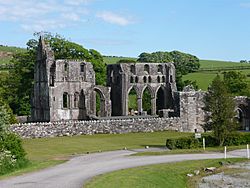Dundrennan Abbey facts for kids
 |
|
| Monastery information | |
|---|---|
| Order | Cistercian |
| Established | 1142 |
| Disestablished | 1606 |
| Mother house | Rievaulx Abbey |
| Diocese | Diocese of Galloway |
| Controlled churches | Kirkmabreck; Rerrick (Dundrennan) |
| People | |
| Founder(s) | Fergus of Galloway |
| Important associated figures | Thomas Livingston |
Dundrennan Abbey is an old Cistercian monastery in Dundrennan, Scotland. It is close to Kirkcudbright. This abbey was built in the Romanesque style.
It was started in 1142 by Fergus of Galloway. Monks from Rievaulx Abbey also helped. King David I of Scotland was involved too.
Even though much of it is now in ruins, Dundrennan Abbey is known for its beautiful and simple design. This design shows the strict rules of the Cistercian monks. The abbey was built from strong grey sandstone. This means its original shapes and details are still very clear today.
Contents
A Royal Visitor: Mary, Queen of Scots
A very famous person stayed at Dundrennan Abbey. Mary, Queen of Scots spent her last night in Scotland here. This was in 1568, after she lost the Battle of Langside.
From a nearby place called Port Mary, she crossed the Solway Firth. She sailed to Workington in England. Soon after, the English captured her and put her in prison.
The Abbey's Story
Dundrennan Abbey was founded in 1142. It was a home for Cistercian monks. These monks lived a simple life. They spent their time praying and working.
In 1587, Scotland went through a big change called the Scottish Reformation. After this, the abbey's land became property of the Crown. The abbey was no longer used as a monastery.
Over time, the buildings fell into ruin. People even used parts of it to keep farm animals. Today, Historic Environment Scotland looks after the site. It is a protected historical place.
Burials at the Abbey
Some important people were buried at Dundrennan Abbey. One of them was:
Images for kids
See also
 In Spanish: Abadía de Dundrennan para niños
In Spanish: Abadía de Dundrennan para niños





